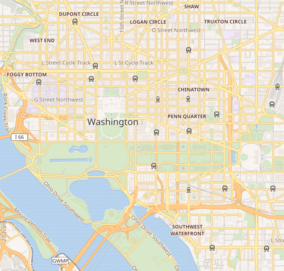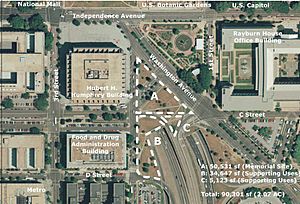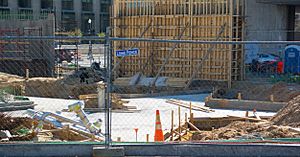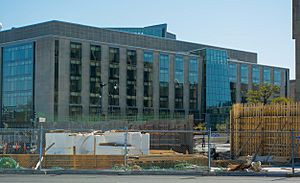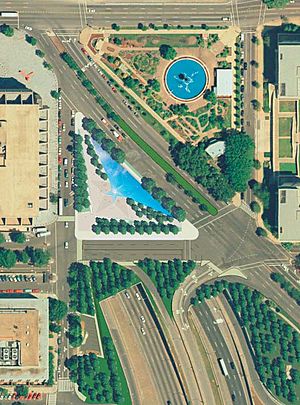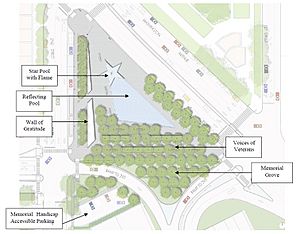American Veterans Disabled for Life Memorial facts for kids
Quick facts for kids American Veterans Disabled for Life Memorial |
|
|---|---|
 |
|
| Location | Washington, D.C., United States |
| Area | 2.4 acres (9,700 m2) |
| Established | October 5, 2014 |
| Governing body | National Park Service |
| Website | NPS: American Veterans Disabled for Life Memorial |
The American Veterans Disabled for Life Memorial is a special place in Washington, D.C. It honors brave men and women from the U.S. armed forces who were permanently injured while serving our country. This memorial reminds everyone of the big sacrifices these veterans made.
The idea for this memorial started in 1995. It took many years of hard work, fundraising, and planning to make it happen. Finally, the memorial was officially opened by President Barack Obama on October 5, 2014.
Contents
How the Memorial Started
The Idea and Early Challenges
The idea for this memorial came from a woman named Lois Pope. In 1995, she visited the Vietnam Veterans Memorial and realized there wasn't a specific place in Washington, D.C., to honor veterans who became permanently disabled. She felt strongly that these heroes deserved their own memorial.
Lois Pope contacted United States Secretary of Veterans Affairs Jesse Brown to ask for his help. She called his office every day for six months until she finally got to speak with him! Secretary Brown agreed to support the idea.
Building a new memorial in Washington, D.C., isn't easy. There's a law called the Commemorative Works Act. This law says that the government can't spend money on memorials, so private groups have to raise all the funds. It also has strict rules about where memorials can be built, especially near the National Mall.
Lois Pope teamed up with Art Wilson, who led the Disabled American Veterans (DAV) organization. Together, they created a new group called the Disabled Veterans for Life Memorial Foundation (DVLMF) in 1998. This foundation would be in charge of raising money and building the memorial.
Getting Approval from Congress
The foundation and its supporters worked hard to get Congress to pass a law allowing the memorial. Important senators like John McCain, Max Cleland, and John Kerry helped introduce the bill.
One big problem was the Commemorative Works Act. It usually prevents new memorials on the National Mall unless 25 years have passed since the event, or if the memorial is super important. In 1999, a group called the National Capital Memorial Commission (NCMC) said no to building the memorial on the Mall. They said there were already many veteran memorials and not much space left.
But the supporters of the memorial didn't give up! They added new words to their bill in Congress to get around this rule. Even though some government agencies didn't like this, Congress quickly approved the bill. President Bill Clinton signed it into law on October 24, 2000. This law meant the foundation had seven years to start building the memorial.
Choosing the Right Spot
The first location the foundation picked was also turned down by the NCMC. They wanted a spot near the National Mall, but the NCMC said no again in 2001. Jesse Brown, who was now helping the foundation, said it was like saying disabled veterans weren't "good enough" for the Mall.
After this, the foundation looked at over 50 possible locations. They worked with officials from Washington, D.C., to find a good spot. They finally chose a triangular piece of land near the United States Capitol and the United States Botanic Garden. This spot was perfect because it was close to important government buildings and museums.
The NCMC, along with other important groups like the National Capital Planning Commission (NCPC) and the United States Commission of Fine Arts (CFA), approved this new site. They liked that it was a garden-like memorial, not a heavy statue. The foundation hoped to start building by spring 2005.
Raising Money for the Memorial
Early Fundraising Efforts
The foundation needed to raise a lot of money – at first, they thought around $35 million, but later it was closer to $60 million. They also needed to save 10% of the construction cost for future maintenance.
Fundraising started in August 2002. They sold special gold coins and ran advertisements with famous people like General Norman Schwarzkopf Jr. and poet Maya Angelou. Lois Pope herself donated $2 million, and the Disabled American Veterans (DAV) also started raising money.
By 2004, the memorial's cost was estimated at $60 million. They held fundraisers and even tried to get the United States Mint to make special commemorative coins to sell. This coin idea passed the Senate but didn't make it through the House of Representatives at first.
More Big Donations and Delays
By 2005, the cost had gone up to $65 million. To help, the foundation hired actor Gary Sinise (who played a disabled veteran in the movie Forrest Gump) to be their national spokesperson. The Veterans of Foreign Wars (VFW) gave $100,000, and Lois Pope made another personal donation of $5 million.
Even with these big donations, fundraising was slow. The groundbreaking date kept getting pushed back. By December 2005, they hoped to start building in 2010. More donations came in 2006, including $1 million from Leo Albert, a former business leader.
Commemorative Coin Success
The idea for a special commemorative coin came up again. In 2007, a bill for the coin passed the House of Representatives with a huge vote of 416 to 0! Senator Tim Johnson then introduced it in the Senate.
The foundation told Congress they had raised about $43 million of the $65 million needed. They believed the coin sales would help them reach their goal quickly. President George W. Bush signed the American Veterans Disabled for Life Commemorative Coin Act into law on July 17, 2008.
These coins sold for $10 each, with most of that money going to the memorial. Only 350,000 coins were made. When they were released in February 2010, over 190,000 were sold in just two months! This really helped boost the fundraising.
Reaching the Goal
Fundraising got much better after the coin sales. Businessman Ross Perot agreed to donate $1 million a year for three years. By November 2008, the total cost of the memorial (including money for maintenance) was $86 million. The DAV also continued to donate, and Lois Pope gave another $5 million.
By October 2009, the foundation was close to its $86 million goal. They were ready to start getting permits to build.
Building the Memorial
Groundbreaking Ceremony
By early 2010, the foundation had almost all the money needed. Lois Pope had given between $8.5 million and $9 million of her own money, and the DAV had donated $10 million. Big companies like AT&T and Ford Motor Company also helped. Since they had 75% of the money and the design was approved, they got permission to start building.
The official groundbreaking ceremony happened on November 10, 2010. Many important people were there, including Lois Pope, Art Wilson, Gary Sinise, and government leaders like Secretary of Veterans Affairs Eric Shinseki and Speaker of the House Nancy Pelosi. Over 400 people, many of them disabled veterans, watched the ceremony. The foundation hoped to open the memorial on Veterans Day in 2012.
Construction Begins
Building the memorial involved many steps. First, they had to move underground utility lines (like phone and electrical cables) that ran beneath the site. This took longer than expected, and the lines weren't fully moved until fall 2012.
Artists and sculptors also began their work. Larry Kirkland was chosen to create the bronze panels for the memorial. A company called Tompkins Builders was hired to manage the construction. Special glass panels were made by Savoy Studios in Oregon, with images and quotes etched into them. Another company, Technifex, designed the special system for the eternal flame.
By November 2012, most of the utilities were moved. The construction of the memorial itself was well underway. The foundation announced that the dedication would happen in October 2014.
Designing the Memorial
Choosing the Design
Designing a memorial in Washington, D.C., involves many approvals from different groups like the NCPC and CFA. The foundation held a design competition, inviting many architects and landscape designers. Six firms submitted ideas.
In July 2003, Michael Vergason Landscape Architects was chosen as the memorial designer. His first idea included a star-shaped fountain, stone walls with stories of veterans, and glass walls with uplifting quotes.
Refining the Design
The design went through several changes based on feedback from the approval committees.
- First Revision: The fountain became a circular granite basin with an eternal flame. Stone walls, called "Walls of Loss," would share veterans' stories. Glass walls, called "Walls of Light," would have inspiring quotes. The site would be paved with grey granite.
- Second Revision: Due to security concerns, the site's shape changed slightly. The star-shaped basin moved to the northern tip of the site. The stone walls were reduced, and a pedestrian walkway was added. The star-shaped basin was raised to help block traffic noise with a water cascade. The glass walls were scattered among trees and would reflect the surroundings. Bronze panels with silhouettes of veterans were added.
- Third Revision: The star-shaped fountain was refined to overflow quietly into a trough. It was raised higher so people in wheelchairs could see the flame. The flame itself was designed to burst from hidden jets. The glass walls, now called "Voices of Veterans," would feature photo-realistic images of veterans and quotes. The bronze panels would be placed behind some glass walls to add visual depth. The "Walls of Loss" were renamed the "Wall of Gratitude" and would be 12 feet high.
The design committees gave their final approval in 2009 and 2010. They made sure the memorial was accessible for everyone, including those with visual or hearing impairments. For example, crosswalks got special bumpy paving and sound signals. An audio tour was also planned for cell phones.
The final design included:
- A star-shaped fountain with an eternal flame.
- A reflecting pool that mirrors the U.S. Capitol.
- A "Wall of Gratitude" made of white granite, with quotes about sacrifice and thanks.
- "Voices of Veterans" glass walls with images and quotes from disabled veterans.
- A peaceful grove of trees.
Dedication
The American Veterans Disabled for Life Memorial was officially opened on October 5, 2014. President Barack Obama spoke to about 3,100 visitors, many of whom were disabled veterans. He said that those who fight for our freedom should "never be shunned and should never be forgotten."
Other important people like Secretary of Veterans Affairs Robert A. McDonald and actor Gary Sinise also spoke. McDonald said, "Few have given more to America. This imposing memorial stands as a powerful reminder of their service and their sacrifice."
About the Memorial
The memorial is located on a 1.72-acre piece of land in Washington, D.C., near the U.S. Capitol. It's managed by the National Park Service.
The memorial has five main parts:
- The Star-Shaped Fountain: This fountain is 30 inches high and made of dark granite. Water gently overflows its sides. In the center is an eternal flame, where natural gas bubbles up and ignites, creating a 3-foot-high flame. Sensors keep the flame burning steadily and turn it off if anyone tries to climb into the fountain.
- The Reflecting Pool: This pool extends from the fountain and is also made of dark granite. It's designed to reflect the nearby U.S. Capitol building, creating a beautiful view.
- The Wall of Gratitude: This wall is 12 feet high and made of almost pure white granite. It has quotes from famous generals like George Washington and Dwight D. Eisenhower, and messages of thanks for disabled veterans. A special opening in the wall points directly to the Capitol dome.
- The Voices of Veterans: This area has three glass walls, made of 49 thick glass panels. On these panels are realistic images of veterans from different wars, along with their powerful quotes about duty, being wounded, and how they dealt with their disabilities. Behind some of the glass panels are four bronze panels with silhouettes of soldiers.
- The Grove of Memorial Trees: The glass walls are set among a peaceful group of trees. There's also a walkway through the trees for people to use.
The memorial also features beautiful landscaping with different types of trees, grasses, and shrubs. Most of the paths are made of gray granite. Special LED lights illuminate the glass walls and benches at night.
The Veterans Disabled for Life Memorial Foundation raised all the money and oversaw the building of this memorial. Now that it's finished, the U.S. federal government owns it, and the National Park Service takes care of it.
- Notes
- Pub.L. 106-348, which established the memorial


